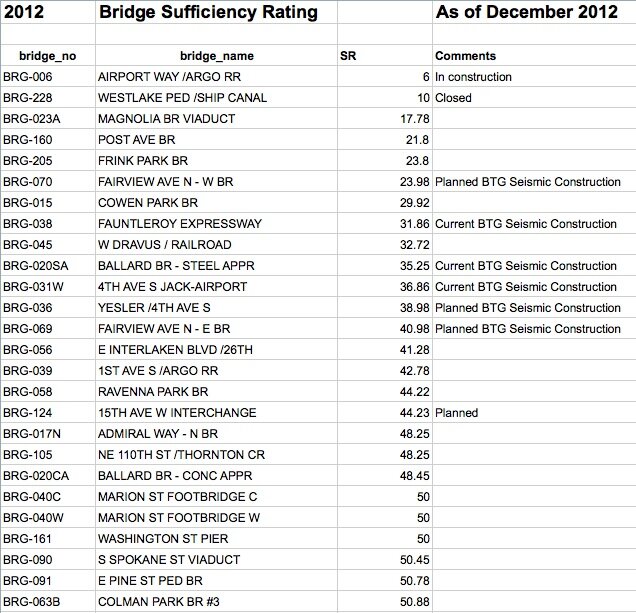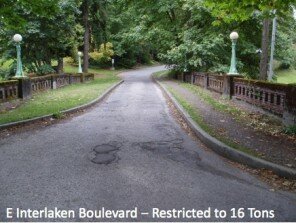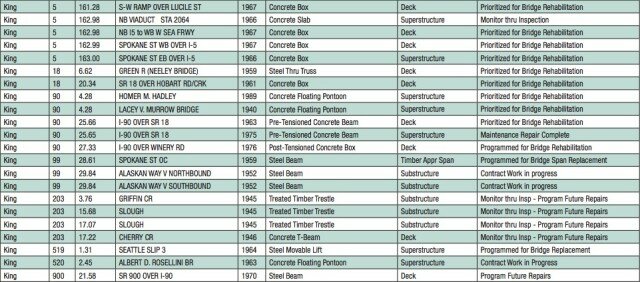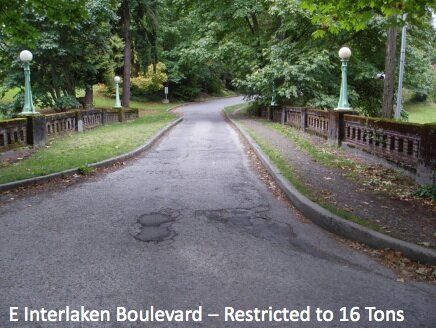
The Alaskan Way Viaduct in Seattle is famous as the elevated roadway that drivers are most likely to hold their breath while crossing.
But the city’s department of transportation has just released a report on their bridge maintenance program (pdf) that explains why drivers may be likely to shake a tooth loose crossing other bridges in town.
As PubliCola notes: “nearly one in three city bridges are in such disrepair that they’re candidates for replacement.”
The report covers the good, bad, and the ugly in Seattle bridges, but it’s worth emphasizing that not all of Seattle’s bridges are bad news. Some 35 percent of Seattle bridges are rated at 80 or higher on the 100-point bride sufficiency scale.
That scale compares the bridge’s condition today with the condition when it was built, says SDOT’s Rick Sheridan. It also measures a bridge’s “performance” through criteria like lane width and capacity. So a low rating doesn’t necessarily point to a safety issue. This is why bridges are further classified as structurally deficient (and often given weight restrictions), or as functionally obsolete.

“All our bridges are safe for use. We would close them if they were not,” responded Sheridan in an email. (“Our” bridges mean those that Seattle owns. The Montlake Bridge, whose deck is seemingly held together by patch-welds, is the responsibility of the Washington Department of Transportation.)
The single most salient factor in a low rating, in Seattle, is age. 62 bridges are more than 60 years old, with a replacement cost that SDOT estimates at $1.5 billion. Another 20 middle-aged bridges are running short on time as well. But since 2007, the bridge maintenance budget — inadequate to begin with — has plunged by more than $400 million. 36 percent of SDOT’s bridges are in fair condition, while only nine percent of WDOT’s bridges are.
Early maintenance is less expensive than late-stage maintenance, and much, much cheaper than replacement. But SDOT estimates that it’s being allocated less than 30 percent of the funds it needs (a total of $190 million annually) to keep up with roads and bridge maintenance. In 2010 SDOT projected $49.2 million yearly for bridge maintenance alone — the city’s 2013 adopted budget includes less than $18 million for that task. Where that missing money might come from is anyone’s guess, with the Bridging the Gap levy (which has not bridged the roadway maintenance gap) set to expire.
Any bridge with a score of less than 80 –which is nearly two-thirds of Seattle’s bridge stock — can be considered for federal funding for repair and improvement. Bridges scoring less than 50 move onto the funding for replacement list. (Recent projects include the José Rizal bridge, 45th Street Viaduct, and seismic retrofitting for the Ballard Bridge.) But Seattle will have to dig into its own pockets as well. If you add in the amount needed for arterial maintenance, that’s billions more.
That’s not mentioning non-arterial city streets, which SDOT has lacked the funds even to assess since the mid-1990s. It’s hard to tell how long Samuel Beckett has been writing the script for road and bridge maintenance in Seattle (“This can’t go on. It must go on”) but you can see, as our bridges reach the end of their 60-year lives, a moment of critical revenue mass approaching.
BONUS GRAPHIC! WSDOT’s list of structurally deficient bridges in King County:

